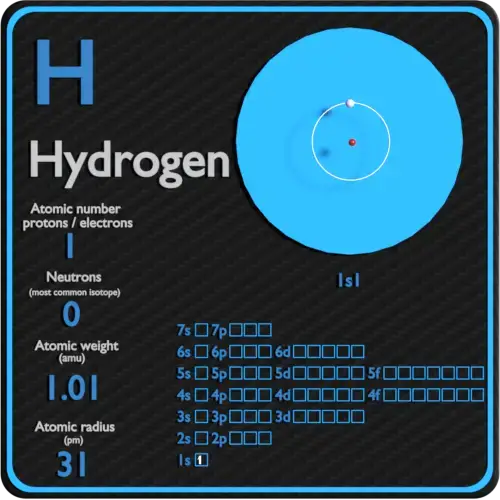
With a standard atomic weight of circa 1.008, hydrogen is the lightest element on the periodic table. Its monatomic class (H) is the nigh abundant chemical substance in the Universe, constituting roughly 75% of all baryonic mass. The largest single utilize of hydrogen in the world is in ammonia industry, which consumes nigh two-thirds of the globe's hydrogen production. Hydrogen is versatile and can be utilized in various ways. In industry, hydrogen is often produced using natural gas, which involves the removal of hydrogen from hydrocarbons at very loftier temperatures, with almost 95% of hydrogen production coming from steam reforming effectually year 2000.
Protons and Neutrons in Hydrogen
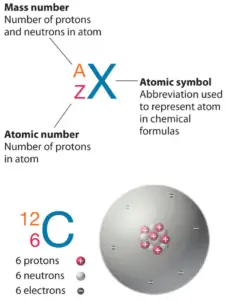 Hydrogen is a chemical element with diminutive number1 which means there are 1 protons in its nucleus. Total number of protons in the nucleus is chosen theatomic number of the atom and is given thesymbol Z. The total electrical charge of the nucleus is therefore +Ze, where e (elementary charge) equals to1,602 x 10-19 coulombs.
Hydrogen is a chemical element with diminutive number1 which means there are 1 protons in its nucleus. Total number of protons in the nucleus is chosen theatomic number of the atom and is given thesymbol Z. The total electrical charge of the nucleus is therefore +Ze, where e (elementary charge) equals to1,602 x 10-19 coulombs.
The total number of neutrons in the nucleus of an cantlet is called theneutron number of the cantlet and is given thesymbol North. Neutron number plus atomic number equals atomic mass number:N+Z=A. The difference between the neutron number and the diminutive number is known as theneutron excess: D = Northward – Z = A – 2Z.
For stable elements, there is usually a variety of stable isotopes. Isotopes are nuclides that have the same diminutive number and are therefore the same chemical element, but differ in the number of neutrons. Mass numbers of typical isotopes of Hydrogen are1; 2.
Common Isotopes of Hydrogen
The almost abundant isotope, hydrogen-1, protium, or light hydrogen, contains no neutrons and is only a proton and an electron. Protium is stable and makes up 99.985% of naturally occurring hydrogen atoms.
Deuterium contains one neutron and 1 proton in its nucleus. Deuterium is stable and makes upwards 0.0156% of naturally occurring hydrogen and is used in industrial processes like nuclear reactors and Nuclear Magnetic Resonance.
Tritium or hydrogen-3 (symbol T or 3H) is a rare and radioactive isotope of hydrogen. The nucleus of tritium (sometimes chosen a triton) contains i proton and two neutrons.
Electrons and Electron Configuration
The number of electrons in an electrically-neutral atom is the aforementioned equally the number of protons in the nucleus. Therefore, the number of electrons in neutral cantlet of Hydrogen is one. Each electron is influenced by the electric fields produced by the positive nuclear charge and the other (Z – 1) negative electrons in the atom.
Since the number of electrons and their arrangement are responsible for the chemical behavior of atoms, theatomic number identifies the various chemical elements. The configuration of these electrons follows from the principles of quantum mechanics. The number of electrons in each element'south electron shells, peculiarly the outermost valence shell, is the chief factor in determining its chemical bonding beliefs. In the periodic table, the elements are listed in order of increasing diminutive number Z.
Electron configuration ofHydrogenis1s1.
Possible oxidation states are+i,-ane.
Hydrogen plays a especially of import office in acid–base of operations reactions because near acrid-base reactions involve the exchange of protons betwixt soluble molecules. In ionic compounds, hydrogen can take the form of a negative charge (i.east., anion) when it is known as a hydride, or as a positively charged (i.eastward., cation) species denoted by the symbol H+. The hydrogen cation is written as though composed of a bare proton, but in reality, hydrogen cations in ionic compounds are always more than circuitous.
Most Mutual Chemical Chemical compound of Hydrogen
H2o is the most common chemical compound of hydrogen. Its chemical formula is H2o, significant that each of its molecules contains one oxygen and ii hydrogen atoms, connected by covalent bonds.Ii hydrogen atoms fastened i oxygen cantlet at bending of 104.45°.
About Protons
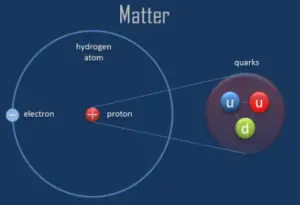 A proton is 1 of the subatomic particles that make upwardly affair. In the universe, protons are arable, making upwardsabout half of all visible affair. Information technology hasa positive electric charge (+1e) and a rest mass equal to 1.67262 × x−27 kg (938.272 MeV/c two )— marginally lighter than that of the neutron but nearly 1836 times greater than that of the electron. The proton has a hateful square radius of about 0.87 × 10−15 m, or 0.87 fm, and it is a spin – ½ fermion.
A proton is 1 of the subatomic particles that make upwardly affair. In the universe, protons are arable, making upwardsabout half of all visible affair. Information technology hasa positive electric charge (+1e) and a rest mass equal to 1.67262 × x−27 kg (938.272 MeV/c two )— marginally lighter than that of the neutron but nearly 1836 times greater than that of the electron. The proton has a hateful square radius of about 0.87 × 10−15 m, or 0.87 fm, and it is a spin – ½ fermion.
The protons exist in the nuclei of typical atoms, along with their neutral counterparts, the neutrons. Neutrons and protons, commonly callednucleons, are leap together in the atomic nucleus, where they account for 99.9 percentage of the atom's mass. Enquiry in high-energy particle physics in the 20th century revealed that neither the neutron nor the protonis not the smallest building block of matter.
About Neutrons
A neutron is one of the subatomic particles that make up thing. In the universe, neutrons are abundant, making upmore than half of all visible matter. It hasno electric accuse and a remainder mass equal to 1.67493 × ten−27 kg—marginally greater than that of the proton just nearly 1839 times greater than that of the electron. The neutron has a mean foursquare radius of well-nigh 0.8×10−15 one thousand, or 0.eight fm, and it is a spin-½ fermion.
Atomic nuclei consist of protons and neutrons, which attract each other throughthe nuclear strength, while protons repel each other viathe electric strength due to their positive charge. These ii forces compete, leading to various stability of nuclei. At that place are only certain combinations of neutrons and protons, which formsstable nuclei.
Neutrons stabilize the nucleus, considering they attract each other and protons , which helps beginning the electrical repulsion between protons. As a result, every bit the number of protons increases,an increasing ratio of neutrons to protons is needed to form a stable nucleus. If there are too many or also few neutrons for a given number of protons, the resulting nucleus is not stable and it undergoes radioactive disuse.Unstable isotopesdecay through various radioactive decay pathways, most commonly alpha decay, beta disuse, or electron capture. Many other rare types of disuse, such as spontaneous fission or neutron emission are known. It should exist noted that all of these disuse pathways may be accompanied bythe subsequent emission of gamma radiation. Pure alpha or beta decays are very rare.
About Electrons and Electron Configuration
The periodic table is a tabular brandish of the chemical elements organized on the basis of their atomic numbers, electron configurations, and chemical backdrop. The electron configuration is the distribution of electrons of an atom or molecule (or other concrete construction) in atomic or molecular orbitals. Noesis of theelectron configuration of different atoms is useful in understanding the structure of the periodic tabular array of elements.
Every solid, liquid, gas, and plasma is composed of neutral or ionized atoms. Thechemic properties of the cantlet are determined by the number of protons, in fact, by number andarrangement of electrons. Theconfiguration of these electrons follows from the principles of quantum mechanics. The number of electrons in each element'due south electron shells, especially the outermost valence beat out, is the primary factor in determining its chemical bonding beliefs. In the periodic table, the elements are listed in order of increasing diminutive number Z.
It is thePauli exclusion principle that requires the electrons in an atom to occupy different energy levels instead of them all condensing in the basis country. The ordering of the electrons in the footing land of multielectron atoms, starts with the everyman free energy state (ground state) and moves progressively from there up the energy scale until each of the atom'southward electrons has been assigned a unique set of quantum numbers. This fact has key implications for the edifice up of the periodic table of elements.
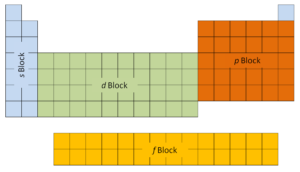 The offset 2 columns on the left side of the periodic table are where thes subshells are beingness occupied. Considering of this, the first two rows of the periodic table are labeled thes cake. Similarly, thep blockare the right-most six columns of the periodic tabular array, thed blockis the middle 10 columns of the periodic tabular array, while thef blockis the 14-column section that is ordinarily depicted equally detached from the main body of the periodic tabular array. Information technology could be part of the main torso, but then the periodic table would be rather long and cumbersome.
The offset 2 columns on the left side of the periodic table are where thes subshells are beingness occupied. Considering of this, the first two rows of the periodic table are labeled thes cake. Similarly, thep blockare the right-most six columns of the periodic tabular array, thed blockis the middle 10 columns of the periodic tabular array, while thef blockis the 14-column section that is ordinarily depicted equally detached from the main body of the periodic tabular array. Information technology could be part of the main torso, but then the periodic table would be rather long and cumbersome.
For atoms with many electrons, this annotation can become lengthy and so an abbreviated notation is used. The electron configuration can be visualized as the core electrons, equivalent to thenoble gas of the preceding period, and the valence electrons (e.g. [Xe] 6s2 for barium).
Oxidation States
Oxidation states are typically represented by integers which may be positive, nothing, or negative. Most elements have more than 1 possible oxidation state. For example, carbon has nine possible integer oxidation states from −4 to +4.
The current IUPAC Gold Book definition of oxidation state is:
"Oxidation land of an atom is the charge of this atom after ionic approximation of its heteronuclear bonds…"
and the term oxidation number is near synonymous. An element that is not combined with whatsoever other unlike elements has an oxidation state of 0. Oxidation state 0 occurs for all elements – it is merely the chemical element in its elemental grade. An atom of an element in a compound volition have a positive oxidation state if it has had electrons removed. Similarly, adding electrons results in a negative oxidation land. We have also distinguish between the possible and mutual oxidation states of every element. For instance, silicon has nine possible integer oxidation states from −iv to +iv, simply only -4, 0 and +4 are mutual oxidation states.
Summary
| Element | Hydrogen |
| Number of protons | 1 |
| Number of neutrons (typical isotopes) | 1; 2 |
| Number of electrons | one |
| Electron configuration | 1s1 |
| Oxidation states | +1,-1 |
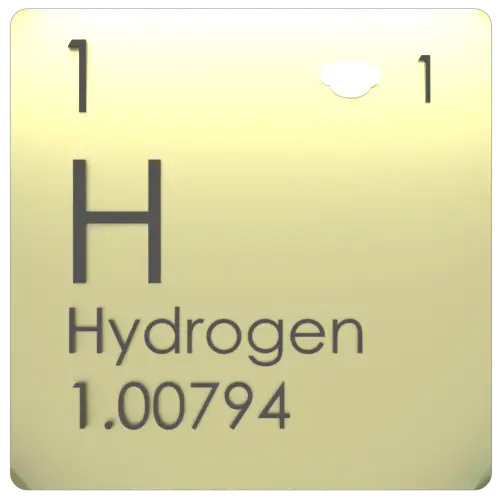
Source: www.luciteria.com
Other properties of Hydrogen

 Hydrogen is a chemical element with diminutive number1 which means there are 1 protons in its nucleus. Total number of protons in the nucleus is chosen theatomic number of the atom and is given thesymbol Z. The total electrical charge of the nucleus is therefore +Ze, where e (elementary charge) equals to1,602 x 10-19 coulombs.
Hydrogen is a chemical element with diminutive number1 which means there are 1 protons in its nucleus. Total number of protons in the nucleus is chosen theatomic number of the atom and is given thesymbol Z. The total electrical charge of the nucleus is therefore +Ze, where e (elementary charge) equals to1,602 x 10-19 coulombs.

 A proton is 1 of the subatomic particles that make upwardly affair. In the universe, protons are arable, making upwardsabout half of all visible affair. Information technology hasa positive electric charge (+1e) and a rest mass equal to 1.67262 × x−27 kg (938.272 MeV/c two )— marginally lighter than that of the neutron but nearly 1836 times greater than that of the electron. The proton has a hateful square radius of about 0.87 × 10−15 m, or 0.87 fm, and it is a spin – ½ fermion.
A proton is 1 of the subatomic particles that make upwardly affair. In the universe, protons are arable, making upwardsabout half of all visible affair. Information technology hasa positive electric charge (+1e) and a rest mass equal to 1.67262 × x−27 kg (938.272 MeV/c two )— marginally lighter than that of the neutron but nearly 1836 times greater than that of the electron. The proton has a hateful square radius of about 0.87 × 10−15 m, or 0.87 fm, and it is a spin – ½ fermion. The offset 2 columns on the left side of the periodic table are where thes subshells are beingness occupied. Considering of this, the first two rows of the periodic table are labeled thes cake. Similarly, thep blockare the right-most six columns of the periodic tabular array, thed blockis the middle 10 columns of the periodic tabular array, while thef blockis the 14-column section that is ordinarily depicted equally detached from the main body of the periodic tabular array. Information technology could be part of the main torso, but then the periodic table would be rather long and cumbersome.
The offset 2 columns on the left side of the periodic table are where thes subshells are beingness occupied. Considering of this, the first two rows of the periodic table are labeled thes cake. Similarly, thep blockare the right-most six columns of the periodic tabular array, thed blockis the middle 10 columns of the periodic tabular array, while thef blockis the 14-column section that is ordinarily depicted equally detached from the main body of the periodic tabular array. Information technology could be part of the main torso, but then the periodic table would be rather long and cumbersome.
0 Response to "How Many Electrons In Hydrogen"
Post a Comment